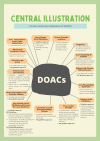Switching from warfarin to direct-acting oral anticoagulants: it is time to move forward!
- PMID: 35347478
- PMCID: PMC8960500
- DOI: 10.1186/s43044-022-00259-9
Switching from warfarin to direct-acting oral anticoagulants: it is time to move forward!
Abstract
Oral vitamin K antagonists (VKAs), warfarin, have been in routine clinical use for almost 70 years for various cardiovascular conditions. Direct-Acting Oral Anticoagulants (DOACs) have emerged as competitive alternatives for VKAs to prevent stroke in patients with non-valvular atrial fibrillation (AF) and have become the preferred choice in several clinical indications for anticoagulation. Recent guidelines have limited the use of DOACs to patients with non-valvular AF to reduce the risk of cardioembolic complications and to treat venous thromboembolism (VTE). Although emerging evidence is suggestive of its high efficacy, there was a lack of data to support DOACs safety profile in patients with mechanical valve prosthesis, intracardiac thrombi, or other conditions such as cardiac device implantation or catheter ablation. Therefore, several clinical trials have been conducted to assess the beneficial effects of using DOACs, instead of VKAs, for various non-guideline-approved indications. This review aimed to discuss the current guideline-approved indications for DOACs, advantages, and limitations of DOACs use in various clinical indications highlighting the potential emerging indications and remaining challenges for DOACs use. Several considerations are in favour of switching from warfarin to DOACs including superior efficacy, better adverse effect profile, fewer drug-drug interactions, and they do not require frequent international normalized ratio (INR) monitoring. Large randomized controlled trials are required to determine the safety and efficacy of their use in various clinical indications.
Keywords: Bleeding; Direct-acting oral anticoagulants; Thromboembolism; Vitamin K antagonists; Warfarin.
© 2022. The Author(s).
Conflict of interest statement
All the authors declare that they have no competing interests.
Figures
Similar articles
-
Optimizing Anticoagulation Strategies in Patients With Atrial Fibrillation and Valvular Heart Disease: A Comprehensive Evidence-Based Review.Cureus. 2025 Mar 27;17(3):e81319. doi: 10.7759/cureus.81319. eCollection 2025 Mar. Cureus. 2025. PMID: 40291263 Free PMC article. Review.
-
Unresolved issues in the use of direct acting oral anticoagulants.Expert Rev Cardiovasc Ther. 2023 Jul-Dec;21(12):913-921. doi: 10.1080/14779072.2023.2271388. Epub 2023 Dec 13. Expert Rev Cardiovasc Ther. 2023. PMID: 37837206 Review.
-
Anticoagulation in Patients with Chronic Kidney Disease.Am J Nephrol. 2024;55(2):146-164. doi: 10.1159/000535546. Epub 2023 Nov 30. Am J Nephrol. 2024. PMID: 38035566 Free PMC article. Review.
-
Use of oral anticoagulants in complex clinical situations with atrial fibrillation.Med Clin (Barc). 2018 Jun;150 Suppl 1:8-24. doi: 10.1016/S0025-7753(18)30666-3. Med Clin (Barc). 2018. PMID: 30502871 Review. English, Spanish.
-
Direct oral anticoagulants versus vitamin K antagonists in patients with atrial fibrillation and stage 5 chronic kidney disease under dialysis: A systematic review and meta-analysis of randomized controlled trials.J Thromb Thrombolysis. 2024 Mar;57(3):381-389. doi: 10.1007/s11239-023-02945-0. Epub 2024 Jan 28. J Thromb Thrombolysis. 2024. PMID: 38281231
Cited by
-
Evaluation and clinical implications of interactions between compound Danshen dropping pill and warfarin associated with the epoxide hydrolase gene.Front Pharmacol. 2023 May 4;14:1105702. doi: 10.3389/fphar.2023.1105702. eCollection 2023. Front Pharmacol. 2023. PMID: 37214448 Free PMC article.
-
Effectiveness and safety in non-valvular atrial fibrillation patients switching from warfarin to direct oral anticoagulants in US healthcare claims.J Thromb Thrombolysis. 2024 Aug;57(6):1092-1102. doi: 10.1007/s11239-024-02976-1. Epub 2024 May 2. J Thromb Thrombolysis. 2024. PMID: 38698197 Free PMC article.
-
Antiplatelet Aggregation Properties of Cirsilineol: A Novel Inhibitor of Blood Coagulation Factor Xa.Pharmaceuticals (Basel). 2023 Apr 14;16(4):588. doi: 10.3390/ph16040588. Pharmaceuticals (Basel). 2023. PMID: 37111345 Free PMC article.
-
Efficacy and Safety of Direct Oral Anticoagulants Versus Warfarin in Saudi Patients With Atrial Fibrillation.Cureus. 2024 Apr 24;16(4):e58886. doi: 10.7759/cureus.58886. eCollection 2024 Apr. Cureus. 2024. PMID: 38800246 Free PMC article.
References
-
- Baumgartner H, Falk V, Bax JJ, De Bonis M, Hamm C, Holm PJ, Iung B, Lancellotti P, Lansac E, Rodriguez Muñoz D, Rosenhek R, Sjögren J, Tornos Mas P, Vahanian A, Walther T, Wendler O, Windecker S, Zamorano JL. 2017 ESC/EACTS Guidelines for the management of valvular heart disease. Eur Heart J. 2017;38:2739–2791. - PubMed
-
- Kirchhof P, Benussi S, Kotecha D, Ahlsson A, Atar D, Casadei B, Castella M, Diener HC, Heidbuchel H, Hendriks J, Hindricks G, Manolis AS, Oldgren J, Popescu BA, Schotten U, Van Putte B, Vardas P, Agewall S, Camm J, Baron Esquivias G, Budts W, Carerj S, Casselman F, Coca A, De Caterina R, Deftereos S, Dobrev D, Ferro JM, Filippatos G, Fitzsimons D, Gorenek B, Guenoun M, Hohnloser SH, Kolh P, Lip GY, Manolis A, McMurray J, Ponikowski P, Rosenhek R, Ruschitzka F, Savelieva I, Sharma S, Suwalski P, Tamargo JL, Taylor CJ, Van Gelder IC, Voors AA, Windecker S, Zamorano JL, Zeppenfeld K. 2016 ESC Guidelines for the management of atrial fibrillation developed in collaboration with EACTS. Eur J Cardiothorac Surg. 2016;50:e1–e88. - PubMed
-
- Wilbur J, Shian B. Deep venous thrombosis and pulmonary embolism: current therapy. Am Fam Phys. 2017;95:295–302. - PubMed
-
- Newall F, Monagle P, Johnston L. Patient understanding of warfarin therapy: a review of education strategies. Hematology. 2005;10:437–442. - PubMed
Publication types
LinkOut - more resources
Full Text Sources




